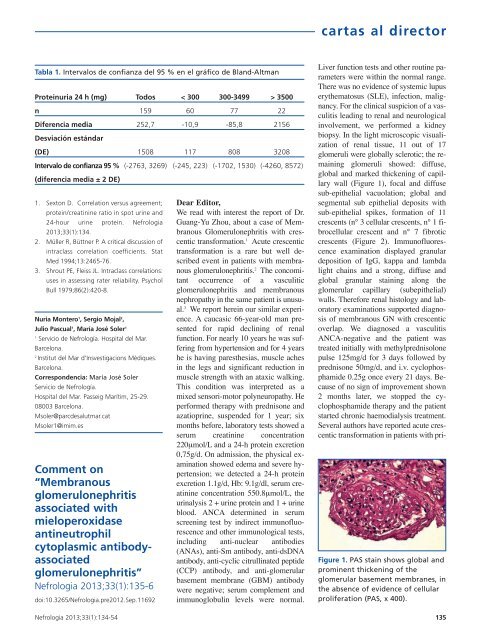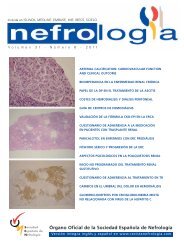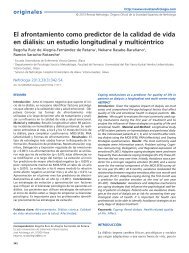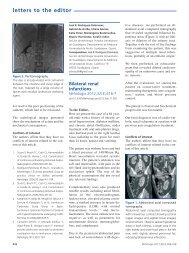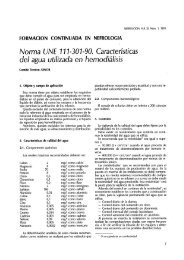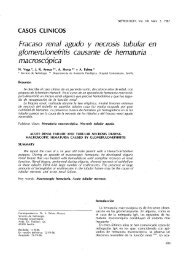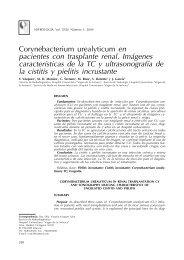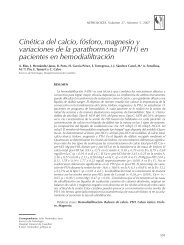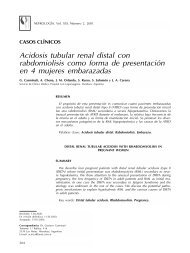PDF Número - NefrologÃa
PDF Número - NefrologÃa
PDF Número - NefrologÃa
You also want an ePaper? Increase the reach of your titles
YUMPU automatically turns print PDFs into web optimized ePapers that Google loves.
cartas al director<br />
Tabla 1. Intervalos de confianza del 95 % en el gráfico de Bland-Altman<br />
Proteinuria 24 h (mg) Todos < 300 300-3499 > 3500<br />
n 159 60 77 22<br />
Diferencia media 252,7 -10,9 -85,8 2156<br />
Desviación estándar<br />
(DE) 1508 117 808 3208<br />
Intervalo de confianza 95 % (-2763, 3269) (-245, 223) (-1702, 1530) (-4260, 8572)<br />
(diferencia media ± 2 DE)<br />
1. Sexton D. Correlation versus agreement;<br />
protein/creatinine ratio in spot urine and<br />
24-hour urine protein. Nefrologia<br />
2013;33(1):134.<br />
2. Müller R, Büttner P. A critical discussion of<br />
intraclass correlation coefficients. Stat<br />
Med 1994;13:2465-76.<br />
3. Shrout PE, Fleiss JL. Intraclass correlations:<br />
uses in assessing rater reliability. Psychol<br />
Bull 1979;86(2):420-8.<br />
Nuria Montero 1 , Sergio Mojal 2 ,<br />
Julio Pascual 1 , María José Soler 1<br />
1<br />
Servicio de Nefrología. Hospital del Mar.<br />
Barcelona.<br />
2<br />
Institut del Mar d’Insvestigacions Mèdiques.<br />
Barcelona.<br />
Correspondencia: María José Soler<br />
Servicio de Nefrología.<br />
Hospital del Mar. Passeig Marítim, 25-29.<br />
08003 Barcelona.<br />
Msoler@parcdesalutmar.cat<br />
Msoler1@imim.es<br />
Comment on<br />
“Membranous<br />
glomerulonephritis<br />
associated with<br />
mieloperoxidase<br />
antineutrophil<br />
cytoplasmic antibodyassociated<br />
glomerulonephritis”<br />
Nefrologia 2013;33(1):135-6<br />
doi:10.3265/Nefrologia.pre2012.Sep.11692<br />
Nefrologia 2013;33(1):134-54<br />
Dear Editor,<br />
We read with interest the report of Dr.<br />
Guang-Yu Zhou, about a case of Membranous<br />
Glomerulonephritis with crescentic<br />
transformation. 1 Acute crescentic<br />
transformation is a rare but well described<br />
event in patients with membranous<br />
glomerulonephritis. 2 The concomitant<br />
occurrence of a vasculitic<br />
glomerulonephritis and membranous<br />
nephropathy in the same patient is unusual.<br />
3 We report herein our similar experience.<br />
A caucasic 66-year-old man presented<br />
for rapid declining of renal<br />
function. For nearly 10 years he was suffering<br />
from hypertension and for 4 years<br />
he is having paresthesias, muscle aches<br />
in the legs and significant reduction in<br />
muscle strength with an ataxic walking.<br />
This condition was interpreted as a<br />
mixed sensori-motor polyneuropathy. He<br />
performed therapy with prednisone and<br />
azatioprine, suspended for 1 year; six<br />
months before, laboratory tests showed a<br />
serum creatinine concentration<br />
220µmol/L and a 24-h protein excretion<br />
0,75g/d. On admission, the physical examination<br />
showed edema and severe hypertension;<br />
we detected a 24-h protein<br />
excretion 1.1g/d, Hb: 9.1g/dl, serum creatinine<br />
concentration 550.8µmol/L, the<br />
urinalysis 2 + urine protein and 1 + urine<br />
blood. ANCA determined in serum<br />
screening test by indirect immunofluorescence<br />
and other immunological tests,<br />
including anti-nuclear antibodies<br />
(ANAs), anti-Sm antibody, anti-dsDNA<br />
antibody, anti-cyclic citrullinated peptide<br />
(CCP) antibody, and anti-glomerular<br />
basement membrane (GBM) antibody<br />
were negative; serum complement and<br />
immunoglobulin levels were normal.<br />
Liver function tests and other routine parameters<br />
were within the normal range.<br />
There was no evidence of systemic lupus<br />
erythematosus (SLE), infection, malignancy.<br />
For the clinical suspicion of a vasculitis<br />
leading to renal and neurological<br />
involvement, we performed a kidney<br />
biopsy. In the light microscopic visualization<br />
of renal tissue, 11 out of 17<br />
glomeruli were globally sclerotic; the remaining<br />
glomeruli showed: diffuse,<br />
global and marked thickening of capillary<br />
wall (Figure 1), focal and diffuse<br />
sub-epithelial vacuolation; global and<br />
segmental sub epithelial deposits with<br />
sub-epithelial spikes, formation of 11<br />
crescents (n° 3 cellular crescents, n° 1 fibrocellular<br />
crescent and n° 7 fibrotic<br />
crescents (Figure 2). Immunofluorescence<br />
examination displayed granular<br />
deposition of IgG, kappa and lambda<br />
light chains and a strong, diffuse and<br />
global granular staining along the<br />
glomerular capillary (subepithelial)<br />
walls. Therefore renal histology and laboratory<br />
examinations supported diagnosis<br />
of membranous GN with crescentic<br />
overlap. We diagnosed a vasculitis<br />
ANCA-negative and the patient was<br />
treated initially with methylprednisolone<br />
pulse 125mg/d for 3 days followed by<br />
prednisone 50mg/d, and i.v. cyclophosphamide<br />
0.25g once every 21 days. Because<br />
of no sign of improvement shown<br />
2 months later, we stopped the cyclophosphamide<br />
therapy and the patient<br />
started chronic haemodialysis treatment.<br />
Several authors have reported acute crescentic<br />
transformation in patients with pri-<br />
Figure 1. PAS stain shows global and<br />
prominent thickening of the<br />
glomerular basement membranes, in<br />
the absence of evidence of cellular<br />
proliferation (PAS, x 400).<br />
135


